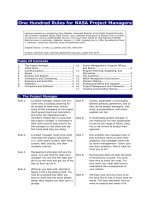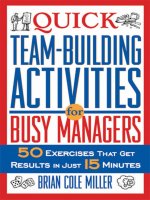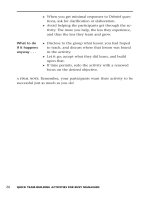Quick Team-Building Activities for Busy Managers: 50 Exercises That Get Results in Just 15 Minutes_8 potx
Bạn đang xem bản rút gọn của tài liệu. Xem và tải ngay bản đầy đủ của tài liệu tại đây (225.93 KB, 19 trang )
BALLOON
SCULPTURES
This is . . . A fun activity in which participants create a balloon
sculpture that reflects the team.
The purpose The group members openly express their commit-
is . . . ment to the team.
Use this ➤ A new team is forming and needs to come together.
when . . .
➤ Creative thinking is not happening very much.
➤ Individuals are not cooperating well.
➤ The group needs a shot in the arm of team spirit.
Materials ➤ One long balloon (the kind circus clowns use) for
you’ll each participant and some extras.
need . . .
➤ A balloon pump (optional but highly recommended,
often included with the purchase of the balloons).
Here’s 1. Give each participant one balloon.
how . . . 2. Have the entire team create a balloon structure
that reflects their commitment to the team.
For Balloons linked together may suggest interdependence,
example . . . balloons touching may represent connectivity, bal-
loons on the bottom may suggest supporting others,
and so forth.
Ask these
➤ How does this activity relate to teamwork? (We
questions . . . had to work together; We had to agree on things;
QUICK TEAM-BUILDING ACTIVITIES FOR BUSY MANAGERS 121
miller chap 07 7/24/03 3:45 PM Page 121
We had to support the final outcome; Each balloon
reflected our individual input; etc.)
➤ How did you deal with everyone’s ideas about the
sculpture?
➤ How did you handle disagreements?
➤ What implication does this have for us back on
the job?
Tips for ➤ Have the balloons blown up before the activity if
success . . . possible.
➤ Have extra balloons ready for the few that will
break.
➤ Do not blow the balloons up completely. Leave an
inch or more to allow for bending and stretching.
➤ Watch for team behaviors during the activity that
you can bring up during the Debrief.
Try these ➤ If the group consists of intact work teams, divide
variations . . . the group into those teams. Have them each create
a sculpture. Then have them share their creation
with the others. If there are fewer than five partic-
ipants in a team, you may need to make more
balloons available for them.
➤ Have the team think of a team name that comple-
ments their sculpture and reinforces their commit-
ment to the team.
➤ Use building blocks instead of balloons. Give each
participant five or more blocks.
➤ Instead of balloons, use your organization’s own
products or items to which your group can partic-
ularly relate.
122 QUICK TEAM-BUILDING ACTIVITIES FOR BUSY MANAGERS
miller chap 07 7/24/03 3:45 PM Page 122
CARD STACK
This is . . . An activity in which participants organize a random
stack of cards into the best arrangement possible.
The purpose Participants learn to cooperate with each other, have
is . . . fun, and reinforce communication skills.
Use this
➤ Individuals need to understand the value of being
when . . . flexible with plans and strategies.
➤ Creative problem solving is not happening very
much.
➤ Individuals are not cooperating well.
Materials ➤ A set of 16 random playing cards for each team.
you’ll
need . . .
Here’s 1. Divide the group into teams of three to five.
how . . . 2. Give each team a set of 16 playing cards.
3. Have the teams lay out all their cards in a grid
(four rows and four columns).
4. The object is for them to reduce the 16 cards
down to one stack, or the smallest number of
stacks possible.
5. Explain these rules:
a. A card (or stack) may be moved any distance
horizontally or vertically, but never diagonally.
b. It must always end its move on top of another
card (or stack) that is the same rank or suit. It
can never take an empty space.
QUICK TEAM-BUILDING ACTIVITIES FOR BUSY MANAGERS 123
miller chap 07 7/24/03 3:45 PM Page 123
c. Once a card is placed on top of another card,
the resulting stack is moved as one unit driven
by its top card (all cards below become irrele-
vant for the remainder of the game).
6. Allow the teams 10 minutes to play.
For A 2 of diamonds may move horizontally 1 space to
example . . . cover a stack topped by a 4 of diamonds (matching
suit) or vertically 3 spaces to cover a 2 of clubs
(matching rank). (It cannot be moved diagonally for
any reason.) Once the 2 is moved to cover the 4, that
4 becomes irrelevant. The new stack, consisting of
the 2, the 4, and cards below the 4, is now moved as
one unit based on the top card, the 2 of diamonds.
Or, the reverse move could have been made. The
stack topped with a 4 of diamonds could have been
moved horizontally to cover the 2 of diamonds.
The resulting stack, with the 2 of diamonds on the
bottom, is now moved according to its top card, the
4 of diamonds.
Ask these
➤ How close were you to the goal of one final stack?
questions . . . ➤ What affected your final result? Since each set of
cards was different, how did available resources
affect the outcome? Does this happen at work?
➤ How did you deal with everyone’s ideas about the
way to proceed?
➤ How does this activity relate to teamwork? (We
had to cooperate; We had to agree on a process;
We had to listen to each other; etc.)
➤ Did anyone emerge as the leader? How did he or
she function?
➤ How did you handle disagreements?
➤ What implications does this have for us back on
the job?
124 QUICK TEAM-BUILDING ACTIVITIES FOR BUSY MANAGERS
miller chap 07 7/24/03 3:45 PM Page 124
Tips for ➤ Post the rules so participants can refer to them
success . . . during play.
➤ Help the teams remember that once a card is on
top of one or more other cards, that card stack
moves as one unit. Only the top card remains
relevant to play.
➤ Stacks can move on top of other stacks to create a
new stack. Again, only the top card remains rele-
vant to play.
➤ Play with a set of cards beforehand so you get a
sense of the card movements.
Try these
➤ Give the teams exactly the same set of 16 cards.
variations . . . Increase the competition by announcing the exact
configuration of cards from which all teams begin
play.
➤ Use more cards for greater difficulty, fewer cards to
finish in less time (but using fewer than 12 cards
does not allow the team to grasp the learning
points).
➤ Allow one diagonal move per game. How does the
added “flexibility” impact the final outcome? Not
all change is bad!
➤ Have the teams remember how they configured
their cards the first time. Play another round, and
see if they can improve their results. Add a level of
change by having one participant from each team
move to a different team for the second round.
How did this new pair of eyes affect the results?
QUICK TEAM-BUILDING ACTIVITIES FOR BUSY MANAGERS 125
miller chap 07 7/24/03 3:45 PM Page 125
CONSULTANTS
This is . . . An activity that allows participants to give each other
advice on how to handle work problems.
The purpose Participants get help solving problems or get creative
is . . . ideas for dealing with work issues.
Use this ➤ Individuals are not helping or supporting each
when . . . other very well.
➤ Individuals need to see the value of others’ input
and help.
➤ You don’t have prep time and/or materials for
anything more elaborate.
Materials ➤ Paper and pens for each participant.
you’ll
need . . .
Here’s 1. Each participant writes one problem or concern he
how . . . or she currently faces at the top of a piece of paper.
Give the group 2 minutes to do this.
2. Have everyone pass their papers to the participant
on their left.
3. Each participant has 1 minute to read the
problem in front of him or her and write some
advice.
4. Pass the papers again, and repeat as often as time
allows.
5. Return the papers to the original owners.
126
QUICK TEAM-BUILDING ACTIVITIES FOR BUSY MANAGERS
miller chap 07 7/24/03 3:45 PM Page 126
For Problem:
example . . .
➤ I have trouble making eye contact when giving
negative feedback.
Solutions:
➤ Try practicing in a mirror.
➤ Make sure your feedback is not attacking or other-
wise making the person feel defensive; then maybe
it won’t be so hard.
➤ Role-play with a friend.
➤ Remember, it may not be as negative as you fear
it is!
➤ Watch how easily Jolene does it, she’s a pro!
Ask these
➤ How many got one or more ideas that will truly
questions . . . help them resolve their issue?
➤ How did you feel having to give advice? (On the
spot, at a loss, honored and respected, pressured to
come up with something fantastic, etc.)
➤ Why do we not ask each other for help more
often? (Do not want to impose, think we have to have
the answer ourselves, do not trust others will have any
good ideas, etc.)
➤ What implications does this have for us back on
the job?
Tips for
➤ Encourage partial advice. If a participant cannot
success . . . think of advice, he or she can write a few words of
encouragement and support or suggest another
resource to go to for advice.
➤ The advice does not have to be revolutionary or
complete. Usually the first thought that comes to
mind is a good one. Even if it is not a very good
one, it may prompt someone else to come up with
a better one!
QUICK TEAM-BUILDING ACTIVITIES FOR BUSY MANAGERS 127
miller chap 07 7/24/03 3:45 PM Page 127
Try these ➤ Sit in a circle. The first participant explains briefly
variations . . . his or her problem or concern. All other partici-
pants take turns offering advice out loud. The first
participant cannot say a word (to explain why
something will not work, for example)—just listen
and thank the others for their help.
➤ This activity can work for creative idea generation
rather than problem solving. For example, where
should we go for our holiday dinner, how can we
increase community service participation, and so
forth.
128 QUICK TEAM-BUILDING ACTIVITIES FOR BUSY MANAGERS
miller chap 07 7/24/03 3:45 PM Page 128
IMPROVE THIS
This is . . . A very quick activity in which participants try to
improve their seating arrangement with no specific
goal in mind.
The purpose Participants learn that objectives or goals must be
is . . . specific; that assumptions left unchecked can sabo-
tage an effort.
Use this ➤ Individuals need to see the value of setting clear
when . . . and specific goals.
➤ Individuals are making assumptions or not asking
questions for clarification.
➤ You don’t have prep time and/or materials for any-
thing more elaborate.
Materials ➤ No materials are necessary for this activity.
you’ll
need . . .
Here’s 1. Announce to the group that they have exactly
how . . . 60 seconds to improve their seating arrangement.
2. Do not give any further instruction. Look at a
clock and tell them to begin . . . now!
3. If they ask for clarification, simply repeat the
original instructions.
4. Stop the activity after 60 seconds and discuss.
Ask these
➤ Did you meet your objective? (Yes, because I am
questions . . . closer to the window; No, because I’m not sure what
the objective was; I’m not sure. . .)
QUICK TEAM-BUILDING ACTIVITIES FOR BUSY MANAGERS 129
miller chap 07 7/24/03 3:45 PM Page 129
➤ What was your objective? Was it clear? (If they
think it was clear, ask them to define “improve,”
and then show how it could have meant to get
more people up front, or to get in a better circle,
or to sit boy–girl–boy–girl, etc., to show there were
assumptions made.)
➤ Did you seek clarification? Why not? Or what
happened when you tried?
➤ How does this situation relate to the workplace?
(We often try to accomplish things when we are not
clear on the real goal or the specific criteria for success;
We often don’t ask for clarification, and if we do, we
don’t press until we get what we truly need to succeed;
etc.)
➤ What can we do to prevent this kind of thing hap-
pening back on the job?
Tips for ➤ After giving the instructions, do not ask if there
success . . . are any questions. Look at the clock to discourage
their questions. It is amazing how quickly anyone
wanting clarification will back off if the source
appears elusive. Usually, the pressure of the group
will discourage anyone from not moving quickly.
➤ If they directly ask for clarification, say, “You deter-
mine for yourselves what “improve” means. You are all
adults. It seems pretty obvious.” During the Debrief,
point out how similar this is to responses back on
the job.
➤ Do not be surprised (and do not stop them!) if
they start moving tables and chairs to “improve”
their seating arrangement.
➤ During the Debrief, do not beat them up for their
behavior. Remember, you set them up. The pur-
pose is to show them how often their work envi-
ronment sets them up like this, and how they
typically respond.
130 QUICK TEAM-BUILDING ACTIVITIES FOR BUSY MANAGERS
miller chap 07 7/24/03 3:45 PM Page 130
➤ As they rearrange themselves, listen to their com-
ments. They will say things such as, “I don’t know
what she wants, but let’s try this. . .” Bring these up
(without pointing at who said what) during the
Debrief.
Try these
➤ This does not have to be done at the beginning of
variations . . . a meeting. Done at any other time, it can also en-
ergize the group that is lagging a bit.
➤ For more focused and in-depth learning, you can
give them a specific work goal and have them
improve it. For example, Improve order processing
is vague, as stated; improving it will be difficult
without getting clarity about successful customer
service. Be more helpful to customers is equally
vague.
➤ After doing this activity as outlined, try variations
wherein you are explicit about what you want
them to accomplish, and see how closely the
group meets your expectations. Let others take a
turn being specific with the goal.
QUICK TEAM-BUILDING ACTIVITIES FOR BUSY MANAGERS 131
miller chap 07 7/24/03 3:45 PM Page 131
ONE-WORDED
STORIES
This is . . . A story telling activity in which participants con-
struct a story together by contributing one word at a
time.
The purpose Participants practice cooperating and making each
is . . . other look good.
Use this ➤ Individuals are not cooperating well.
when . . .
➤ Individuals are focusing too much on themselves.
➤ You don’t have prep time and/or materials for any-
thing more elaborate.
Materials
➤ No materials are necessary for this activity.
you’ll
need . . .
Here’s 1. Explain that the group will create a story together,
how . . . one word at a time.
2. The word used must be as interesting as possible,
and it must make the word of the preceding par-
ticipant work as well as possible.
3. Select one participant to demonstrate how “Once
upon a time. . .” might come out with each of you
alternating saying those words.
4. After the story is over, try another one or two (the
group will get better at this).
132
QUICK TEAM-BUILDING ACTIVITIES FOR BUSY MANAGERS
miller chap 07 7/24/03 3:45 PM Page 132
For Participant 1: “Once”
example . . . Participant 2: “upon”
Participant 3: “a”
Participant 4: “time”
Participant 5: “my”
Participant 6: “uncle”
Participant 7: “and”
Participant 8: “his”
Participant 9: “ugly. . .”
Ask these
➤ How many felt the person after you said the
questions . . . “wrong” word, because that was not what you
meant to have come out? How did that make
you feel? (Angry, frustrated, critical, etc.)
➤ How would you compare the collective story of
the group with what you may have come up with
on your own? (It was more creative and original; It
made less sense; It was more fun; etc.)
➤ Who did not like where the story went? Why not?
What could you have done had this been a work
situation?
➤ Which story was the best? Why?
➤ What implications does this have for us back on
the job, especially when someone does not under-
stand what you intended?
Tips for
➤ Keep the pace moving along quickly, or the flow
success . . . of story will be lost repeatedly.
➤ End the story when it feels like it has run its
course, or the energy and enthusiasm for that one
has waned.
➤ Encourage participants to speak loudly and very
clearly.
Try these ➤ To keep the story moving, allow participants the
variations . . . option of pointing to the next person when they
QUICK TEAM-BUILDING ACTIVITIES FOR BUSY MANAGERS 133
miller chap 07 7/24/03 3:45 PM Page 133
want to pass. Afterwards, ask how the group felt
about those who passed. Did anyone pass more
than others? How does the group interpret that
behavior? Are there some who “pass” at work
more often than others?
➤ To encourage teamwork, allow other participants
to offer to take someone’s turn if they hesitate.
Afterwards, ask the how the group felt about those
who offered help. Did anyone hesitate more than
others? Did anyone jump to the rescue more
than others?
➤ Use paper. Have each participant start a poem with
one line. Pass to the left. Add a line that rhymes.
Pass to the left four more times. Read the poems
out loud.
➤ Don’t take turns at all. Let whoever wants to add a
word do so. Did someone dominate? Did anyone
not participate?
134 QUICK TEAM-BUILDING ACTIVITIES FOR BUSY MANAGERS
miller chap 07 7/24/03 3:45 PM Page 134
PAPER SHUFFLE
This is . . . An activity in which participants put a newspaper in
numerical or page order after it has been shuffled.
The purpose Participants learn to cooperate with each other, have
is . . . fun, and reinforce communication skills.
Use this
➤ Individuals are not cooperating well.
when . . . ➤ A new group is forming and needs to come together.
➤ The group needs to loosen up, have some fun, and
laugh.
Materials ➤ One newspaper with all pages completely shuffled
you’ll and out of order for each team.
need . . . ➤ Small prizes for the winning team (optional).
Here’s 1. Divide the group into teams of four to six
how . . . participants.
2. Give each team one newspaper, completely shuffled.
3. Have the team sort and reorganize the newspaper
back into its original order.
Ask these
➤ How does this activity relate to teamwork? (We
questions . . . had to cooperate; We had to agree on a process;
We had to listen to each other; etc.)
➤ How did you deal with everyone’s ideas about the
way to proceed?
➤ Did anyone emerge as the leader? How did he or
she function?
➤ How did you handle disagreements?
QUICK TEAM-BUILDING ACTIVITIES FOR BUSY MANAGERS 135
miller chap 07 7/24/03 3:45 PM Page 135
➤ What implications does this have for us back on
the job?
Tips for ➤ Use an identical newspaper for each team. If you
success . . . use other materials, make sure the number of
pages given to each team is equal.
➤ Do not give any suggestions or advice before or
during the task. Let the team members figure
things out for themselves.
Try these ➤ Use pages ripped from an old book, but cut off the
variations . . . page numbers first!
➤ Use a long document from your organization,
such as a procedures manual.
➤ Do not allow the participants to speak during this
activity.
➤ If the group is too small to form teams, time the
group performing the task. Then reshuffle the
paper and see if they can improve their time.
➤ A follow-up activity for fun and to build cama-
raderie is to have each team use their newspaper
and some tape to create a costume for one of
their teammates. The teams can compete for most
original, most funny, most beautiful, and so forth.
136 QUICK TEAM-BUILDING ACTIVITIES FOR BUSY MANAGERS
miller chap 07 7/24/03 3:45 PM Page 136
CHAPTER 8
Teamwork:
Appreciating
and Supporting
Each Other
miller chap 08 7/24/03 3:48 PM Page 137
BLAME GAME
This is . . . A quick standstill activity in which participants
try to determine who moved first and then assign
blame.
The purpose Participants see that everyone is responsible for
is . . . group behavior.
Use this
➤ Individuals blame others for group problems that
when . . . they also influence.
➤ Energy is being wasted finding culprits and
scapegoats.
➤ You don’t have prep time and/or materials for
anything more elaborate.
Materials
➤ No materials are necessary for this activity.
you’ll
need . . .
Here’s 1. Arrange the group in a large circle, with everyone
how . . . standing.
2. Find your Idol:
a. You begin by pointing to someone in the circle.
Keep pointing.
b. That participant now points to someone else
and keeps pointing.
c. Continue until everyone is pointing at some-
one else, and the last participant then points
at you.
138
QUICK TEAM-BUILDING ACTIVITIES FOR BUSY MANAGERS
miller chap 08 7/24/03 3:48 PM Page 138
d. Stop pointing (drop your hands) and fix your
eyes on the participant you were pointing at.
That participant becomes your Idol.
3. Explain that the objective is to watch your Idol
closely and copy his or her every action.
4. Now ask the group to stand perfectly still. No one
may move unless his or her Idol does. And if his or
her Idol moves (twitches, coughs, blinks, etc.), he
or she is to mimic that movement exactly and
then be still again.
5. Begin the game and play for several minutes.
Ask these ➤ We were supposed to stand still—what happened?
questions . . . (Expect some participants immediately to start
blaming their Idol for moving.)
➤ Who knows who started the movement? (Allow
for some accusations; inevitably it will be difficult
or impossible to pinpoint who really started each
movement.)
➤ How much does it matter who started it, once it
got started?
➤ How much energy do we spend looking for
scapegoats?
➤ How are we to blame for perpetuating certain
behaviors that eventually become team norms?
What examples of this do we have here at work?
➤ What implications does this have for us back on
the job?
Tips for
➤ Small movements are bound to happen. When
success . . . they do, the movement will be duplicated
around the group endlessly. Usually it will
be exaggerated.
➤ If the movement gets out of hand, just stop the
game, refocus everyone, and start again.
QUICK TEAM-BUILDING ACTIVITIES FOR BUSY MANAGERS 139
miller chap 08 7/24/03 3:48 PM Page 139









